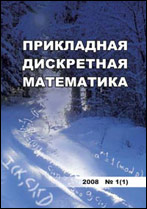|
This article is cited in 1 scientific paper (total in 1 paper)
Theoretical Backgrounds of Applied Discrete Mathematics
On constructing APN permutations using subfunctions
V. A. Idrisovaab
a Sobolev Institute of Mathematics, Novosibirsk, Russia
b Novosibirsk State University, Novosibirsk, Russia
Abstract:
Our subject for investigation is the problem of APN permutation existence for even number of variables. In this work, we consider $2$-to-$1$ functions that are isomorphic to $(n-1)$-subfunctions of APN permutations. These $2$-to-$1$ functions can be obtained with a special algorithm which searches for $2$-to-$1$ APN functions that are potentially EA-equivalent to permutations. The algorithm is based on constructing special symbol sequences that are called admissible. It is known that $(n-1)$-subfunction of an APN permutation can be represented as a differentially $4$-uniform $2$-to-$1$ function that takes values from the half of the Boolean cube. Therefore, the following algorithm can be used to search for APN permutations. On the first step all the possible admissible sequences are constructed and we assign obtained sequences in order to find a differentially $4$-uniform $2$-to-$1$ function. Therefore, obtained function can be isomorphic to a $(n-1)$-subfunction of an APN permutation, so, this $(n-1)$-subfunction can be expanded to bijective APN function. In order to construct an APN permutation, we need to find all possible coordinate Boolean functions $f$ such that the bijective function constructed from the given $(n-1)$-subfunction $S$ and function $f$ is APN. Unfortunately, the exhaustive search through the set of potential coordinate functions is computationally hard when $n\ge7$, so, we need to estimate the number $n(S)$ of such coordinate Boolean functions. For a given bijective vectorial function $F$, we introduce an associated permutation $F^\star$ as follows. We split the set $\mathbb F_2^n$ into two disjoint subsets $\mathcal F_1$ and $\mathcal F_2$, fix integer $k$, indices $i_1,\dots,i_k$, and index $j\not\in\{i_1,\dots,i_k\}$. Then the value $F^\star(x)$ is equal to $F(x)$ if $F(x)\in\mathcal F_1$ and $F^\star(x)$ is equal to $F(x)+e_j$ otherwise. We prove that $F^\star$ is an APN permutation if and only if $F$ is an APN permutation. This fact allows us to obtain the necessary bound. We prove that if $n(S)$ is not equal to zero, then $n(S)\ge2^n$.
Keywords:
vectorial function, APN function, permutation, subfunction.
Citation:
V. A. Idrisova, “On constructing APN permutations using subfunctions”, Prikl. Diskr. Mat., 2018, no. 41, 17–27
Linking options:
https://www.mathnet.ru/eng/pdm633 https://www.mathnet.ru/eng/pdm/y2018/i3/p17
|

| Statistics & downloads: |
| Abstract page: | 336 | | Full-text PDF : | 176 | | References: | 46 |
|




 Contact us:
Contact us: Terms of Use
Terms of Use
 Registration to the website
Registration to the website Logotypes
Logotypes









 Citation in format
Citation in format 
